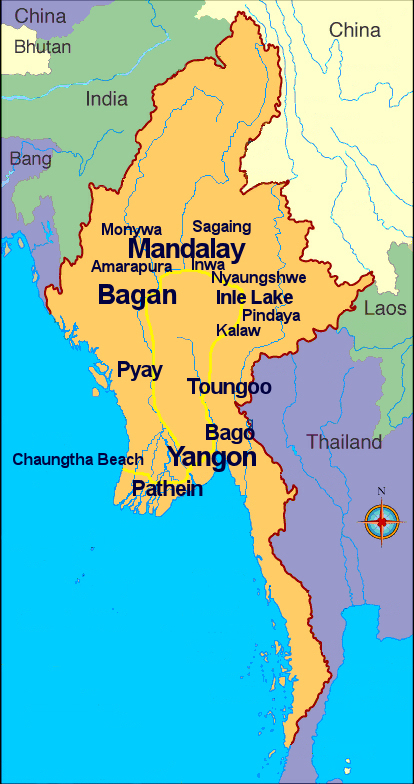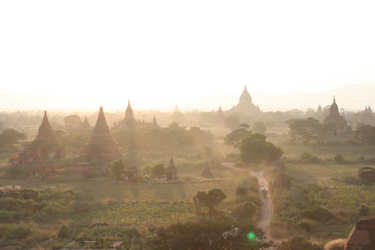Myanmar

Historie
Archaeological evidence shows that Homo erectus lived in the region now known as Myanmar as early as 750.000 years ago, with no more
erectus finds after 75.000 years ago.
The first evidence of Homo sapiens is dated about 11.000 BC with discoveries of stone tools in central Myanmar. Evidence of Neolithic
age domestication of plants and animals and the use of polished stone tools dating to sometime between 10.000 and 6.000 BC has been discovered
in the form of cave paintings in Padah-Lin Caves.
The Bronze Age arrived circa 1.500 BC when people in the region were turning copper into bronze, growing rice and domesticating poultry and
pigs; they were among the first people in the world to do so. Human remains and artefacts from this era were discovered in Monywa District.
The Iron Age began around 500 BC with the emergence of iron-working settlements in an area south of present-day Mandalay.
Around the second century BC the first-known city-states emerged in central Myanmar. The city-states were founded as part of the southward migration
by the Tibeto-Burman-speaking Pyu people, from present-day Yunnan.
The Pyu culture was heavily influenced by trade with India, importing Buddhism as well as other cultural, architectural and political concepts,
which would have an enduring influence on later Burmese culture and political organisation.
By the 9th century, several city-states had sprouted across the land: the Pyu in the central dry zone, Mon along the southern
coastline and Arakanese along the western littoral.
The Kingdom of Pagan grew out of a small 9th-century settlement at Pagan (Bagan) by the Mranma (Burmans), who had recently entered
the Irrawaddy valley from the Kingdom of Nanzhao.
Over the next two hundred years, the small principality gradually grew to absorb its surrounding regions until the 1050s and 1060s when
King Anawrahta founded the Pagan Empire, for the first time unifying under one polity the Irrawaddy valley and its periphery.
By the late 12th century Anawrahta's successors had extended their influence farther to the south into the upper Malay peninsula, to the east
at least to the Salween river, in the farther north to below the current China border, and to the west, in northern Arakan and the Chin Hills.
In the 12th and 13th centuries, Pagan, alongside the Khmer Empire, was one of two main empires in mainland Southeast Asia.
Theravada Buddhism slowly began to spread to the village level, although Tantric, Mahayana, Hinduism, and
folk religion remained heavily entrenched. Pagan's rulers and wealthy built over 10.000 Buddhist temples in the Pagan capital zone alone.
Repeated Mongol invasions (1277–1301) toppled the four-century-old kingdom in 1287.
Pagan's collapse was followed by 250 years of political fragmentation that lasted well into the 16th century. Like the Burmans four centuries
earlier, Shan migrants who arrived with the Mongol invasions stayed behind. Several competing Shan States came to dominate the entire
northwestern to eastern arc surrounding the Irrawaddy valley. The valley too was beset with petty states until the late 14th century when two
sizeable powers, Ava Kingdom and Hanthawaddy Kingdom, emerged.
In the west, a politically fragmented Arakan was under competing influences of its stronger neighbours until the Kingdom of
Mrauk U unified the Arakan coastline for the first time in 1437. The kingdom was a protectorate of the Bengal Sultanate at different
time periods.
Early on, Ava fought Wars of Unification (1385–1424) but could never quite reassemble the lost empire.
Having held off Ava, the Mon-speaking Hanthawaddy entered its golden age, and Kingdom of Mrauk U went on to become a power in its own right for
the next 350 years. In contrast, constant warfare left Ava greatly weakened, and it slowly disintegrated from 1481 onward.
In 1527, the Confederation of Shan States conquered Ava itself, and ruled Upper Myanmar until 1555.
Political unification returned in the mid-16th century, due to the efforts of Taungoo, a former vassal state of Ava. Taungoo's young,
ambitious king Tabinshwehti defeated the more powerful Hanthawaddy in the Toungoo–Hanthawaddy War (1534–41).
His successor Bayinnaung went on to conquer a vast swath of mainland Southeast Asia including the Shan states, Lan Na, Manipur, Mong Mao,
the Ayutthaya Kingdom, Lan Xang and southern Arakan. However, the largest empire in the history of Southeast Asia unravelled soon after
Bayinnaung's death in 1581, completely collapsing by 1599.
The dynasty quickly regrouped under the leadership of Nyaungyan Min and his son, Anaukpetlun, who succeeded in restoring a smaller,
more manageable kingdom, encompassing Lower Burma, Upper Burma, Shan States and Lan Na by 1622.
The Restored Toungoo kings, now based in Ava (Inwa), created a legal and political system whose basic features would continue under the
Konbaung dynasty well into the 19th century. The crown completely replaced the hereditary chieftainships with appointed governorships in
the entire Irrawaddy valley and greatly reduced the hereditary rights of Shan chiefs. Its trade and secular administrative reforms built a
prosperous economy for more than 80 years.
The kingdom entered a gradual decline due to the "palace rule" of its kings. Starting from the 1720s, the kingdom was beset with raids by the
Meitei people of the Chindwin River, and a rebellion in Chiang Mai.
Raids by the Meitei intensified in the 1730s, reaching increasingly deeper parts of central Burma. In 1740, the Mon people in Lower Burma began
a rebellion, founding the Restored Hanthawaddy Kingdom. The Hanthawaddy armies captured Inwa in 1752 and ended the 266-year-old Toungoo
dynasty.
The eighteenth century saw Burmese rulers, whose country had not previously been of particular interest to European traders, seek to maintain
their traditional influence in the western areas of Assam, Manipur and Arakan. Pressing them, however, was the British East India Company,
which was expanding its interests eastwards over the same territory. Over the next sixty years, diplomacy, raids, treaties and compromises
continued until, after three Anglo-Burmese Wars (1824–1885), Britain proclaimed control over most of Burma.
British rule brought social, economic, cultural and administrative changes. Rangoon became the capital of British Burma and an important
port between Calcutta and Singapore.
On 4 January 1948, the nation became an independent republic, under the terms of the Burma Independence Act 1947. The new country was
named the Union of Burma, with Sao Shwe Thaik as its first President. Unlike most other former British colonies and overseas
territories, Burma did not become a member of the Commonwealth.
On 2 March 1962, the military led by General Ne Win took control of Burma through a coup d'état, and the government has been under
direct or indirect control by the military since then. Between 1962 and 1974, Myanmar was ruled by a revolutionary council headed by the
general. Almost all aspects of society (business, media, production) were nationalised or brought under government control under the
Burmese Way to Socialism, which combined Soviet-style nationalisation and central planning.
A new constitution of the Socialist Republic of the Union of Burma was adopted in 1974. Until 1988, the country was ruled as a one-party
system, with the General and other military officers resigning and ruling through the Burma Socialist Programme Party (BSPP).
In May 1990, the government held free elections for the first time in almost 30 years and the National League for Democracy (NLD), the party
of Aung San Suu Kyi, won 392 out of a total 492 seats.
However, the military junta refused to cede power and continued to rule the nation until its dissolution in March 2011.
The series of reforms that followed includes the release of pro-democracy leader Aung San Suu Kyi from house arrest, the establishment of the
National Human Rights Commission, the granting of general amnesties for more than 200 political prisoners, new labour laws that permit
labour unions and strikes, a relaxation of press censorship, and the regulation of currency practices.
General elections were held on 8 November 2015. The results gave the National League for Democracy an absolute majority of seats in both
chambers of the national parliament, enough to ensure that Htin Kyaw would become president.
On 6 April 2016, Aung San Suu Kyi assumed the newly created role of State Counsellor, a role akin to a Prime Minister.
I visited Myanmar in december 2006
These are the places I have seen on that trip
Yangon
Bago
Toungoo
Kalaw
Pindaya
Nyaungshwe
Mandalay
Inwa
Sagaing
Amarapura
Monywa
Bagan
Pyay
Pathein
Chaungtha Beach
Please let me know when you're having questions.
i would be pleased to help you.
Things to do and other tips
